My wife and I recently stopped for lunch at Café Zupas, part of an exploding chain of “fast-casual” restaurants that started in Provo, Utah in 2004. While my wife enjoyed the tasty cuisine and carried on a one-sided conversation, I drifted into another dimension (a place familiar to the Systems Thinker) where motion slows and details become crystal clear, a place where you see things not visible to others. With the amplified power of Systems Thinking, I observed the intricate “ecosystem” of Café Zupas’ business operation.
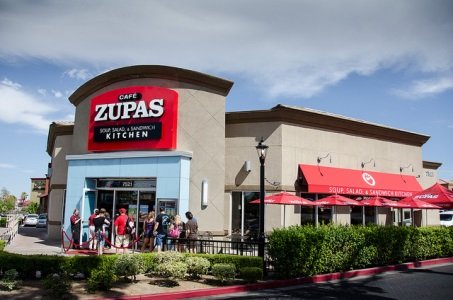
This out-of-body experience began as I read a sign on the restaurant wall that read:
“We’re obsessed with Soup, Salads, Sandwiches, and Desserts. We’ve searched the world for just the right recipes, with just the right ingredients. It’s all about culture, tradition, and ancestry. And it’s about artistry. Perfection is made from scratch; it’s fresh, homemade, and unique. Let our passion for taste and texture be your invitation to join the Zupas obsession.”
Systems Thinkers from the Get-Go
The restaurant chain was the idea of two former “software guys.” During an interview, partner Dustin Schulties said, “Our background in software helped us in creating systems for how we order, prep and use ingredients.“
The sign on the wall also reveals that these budding restaurateurs began by “searching the world over for just the right recipes, with just the right ingredients.” The concept of recipes is profoundly important for everyone trying to start and grow a successful business enterprise, including YOU!
Each recipe they found in their search is a unique system of ingredients and instructions for preparing or processing the food. Every dish is made with exactness, and the end result is a culinary sensation. Combined, these distinctive and exclusive recipes are the basis for a winning business model.
For example, you might enjoy a Wisconsin Cauliflower soup, a Glazed Chicken Chipotle salad, or a Turkey Spinach Artichoke sandwich. For dessert, you’ll die for the Triberry Cheesecake or the Chocolate Hazelnut Crème Brûlée.

What is Your Recipe for Success?
A recipe is nothing more than a formula for creating something wonderful—repeatedly—with the same customer-pleasing result. (People are lined up at Café Zupas every time we go).
I once worked with a large import retailer who did flower arranging. They had “recipes” that included specific flowers, greens, and vases organized for a certain look that customers loved. I did work for a social media company that produced Facebook posts according to a recipe that earned lots of “Likes.”
When music artists develop their own sound, and people buy their songs, they have a winning recipe that can last for decades. The same goes for movie themes such as Marvel Comics or James Bond. In our free-market system, recipes that aren’t popular, will not endure.

Photo from “Recipe to Riches” Australian Television
So, maybe you don’t think that creating popular recipes applies to your business. Think again!
A local landscaper has a package deal for lawn maintenance, and he installs a water feature his customers love—both recipes. A sign-maker displays her unique recipe for signage (style, color, fonts, etc.) that generates a stack of orders and referrals.
A home builder shows eight floorplans in his catalog. He keeps the best sellers, drops the slow sellers, and adds new floor-plan “recipes” each year. Like pizza toppings or sandwich fillings, customers choose the “ingredients” they want for their new home—paint color, carpet, countertops, and so forth.
When I was young, my family had a business that manufactured framed art. We created a design theme called “Silhouettes” that featured black trees, sailboats, or other illustrations printed on glass and set against a beautiful sunset background that was recessed in the wood picture frame. The phone rang non-stop for two years. Our retail customers couldn’t keep them in the stores. As a product, it was a winning recipe, eventually copied by some of our competitors.
Your Business is Like a Chocolate Cake
Recipes are all about your ability to create a remarkable product or service that folks will line up for. It’s the combination of ingredients and processes (e.g., message, presentation, pricing, guarantee, return merchandise policy, courtesy and knowledge of employees, store cleanliness, delivery time, and so forth) that make the recipe unique and better than your competition.
When you follow the precise instructions to make a chocolate cake, you get the same result every time. However, we probably agree that not all chocolate cakes are alike. Have you tried “Death by Chocolate” or ”Chocolate Thunder?” A simple recipe enhancement can make all the difference.
The same holds true with your recipe for generating sales leads, hiring the best people, delivering customer service, or fulfilling orders. A little change in ingredients or procedures can give a far superior result.
(And be sure to give your recipe—your exceptional business system—a great name.)
The Law of Cause and Effect
A business system or process—whether in the store, the office, or the workshop—is merely a proven recipe to get things done in a specific, pre-determined, and consistent way. Systems are governed by the Law of Cause and Effect; things happen for a reason. The effect or result of a business process is determined by the ingredients used, and the procedure followed.
Correctly designed, your business systems support the mission, strategy, and goals of your organization. While people may come and go, the successful recipes you have created remain constant. Furthermore, the better your recipes, the more customer loyalty, profitability, and growth you will enjoy!
In short, your entire business is made up of systems and processes—recipes—that can be managed and improved. By applying correct principles, which include just the right ingredients and precise steps, your systems will produce desired results every time. There is no other way!
A Franchise Prototype
Your entire business is a book of recipes that people will love—OR NOT. It contains your products, services, and internal systems and processes. It includes your recipes for finding exceptional people, training workers, wowing customers, attracting attention in a crowded marketplace, and so forth. It is the unique way you do things in your business operation. (I might add, Box Theory™ Software is perfectly suited to create and store all your favorite business recipes.)
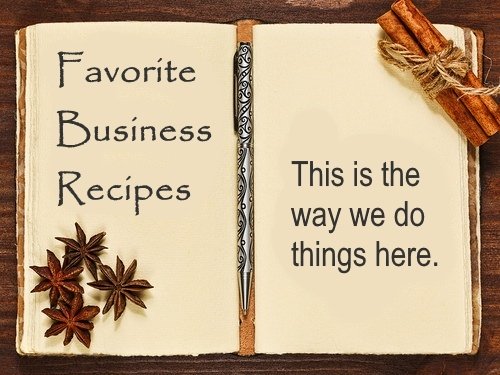
Cubby’s, Costa Vida, Arby’s, Subway, Studio Pizza, Smash Burger, Zaxby’s, McDonald’s, Del Taco, and a dozen other fast-food restaurants are close to my home. Each developed their own recipes for remarkable business systems and processes that began as a “franchise prototype” (Michael Gerber, E-Myth Revisited).
Whether you replicate your business or not, a systemized operation will put more money in your pocket, enable others to run the company when you’re not around, and prepare you to one day sell the business for top dollar—all the things you expect from your financial investment and hard work.
What Sets Café Zupas Apart?
Let’s go back to Café Zupas. They have attractive, well-run, and efficient stores, but there is more to the story.
From their website, store signs, and printed menu, the System Thinker gets a glimpse into the underlying cause of their excellent reputation and popularity. Below are some phrases I see in their marketing copy. I have italicized elements of their strategy, business model, and distinctive recipe for success.
- “Our delicious recipes are derived from gourmet kitchens around the world.”
- “We begin with fresh produce; the best quality ingredients delivered to our door each morning from local suppliers.”

- “We’re passionate about creating kitchen-fresh food the old-fashioned way, and we know you can taste the difference.”
- “Join us every spring and fall as we explore the flavors of the world with our World Tour of Soup.”
- “The complimentary chocolate-dipped strawberry we give each of our guests is our unique way of saying thank you. It’s a symbol of the extra care we give to everything we do.”

- “We strive to cheerfully serve our guests in such a way they feel at home and cared for.”
- “We love to provide a place that is fun, inviting, and unique. Our relationship with our guests, our employees, and our local suppliers is what makes Café Zupas great.”
- As we expand with new locations every year, we stay committed to making our food the same way, offering our guests fresh, delicious, artisan meals.”
Have you thought about your offering in this kind of detail? Are you communicating it well? What is your “sensory package” to attract and retain customers—words, colors, logo, printed materials, signage, sound, touch, smell, or taste?
(My wife recently took the car for an oil change and found a silk rose left on the dashboard—an unexpected gesture from an auto repair shop.)
Do you see how every repeated thing you do is a recipe or system to get a consistently desirable result? Café Zupas’ website, store layout, menu, and thank-you chocolate strawberry are all elements of their business systems and processes. YOUR company should promote similar features and benefits!
A Brief Time Out
In my continued out-of-body experience, I’m hovering over my wife as she tries to engage with my empty shell. Looking around, I observe dozens of smiling patrons and engaged workers. I wonder what they are really thinking about their experience at Café Zupas. I wonder if things are as rosy as they appear.

Clues from Customer Reviews
We have peeked into Zupas’ business strategy and their recipe for a business model, but let’s dig a little deeper to see how they are doing with their other business systems and processes—those you may have in common. Consider with me what patrons are saying online.
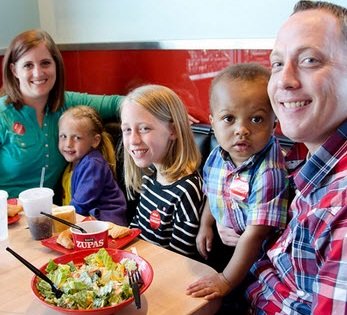
Most of the hundred customer reviews I read were very positive—4 to 5-star ratings. The owners should be very gratified. I have noted below some suggestions that point to the company’s business systems, followed by my comments as a Systems Thinker (italics added for emphasis).
- “We were greeted at the door (yes, there is a greeter) as an employee passed out menus to view while waiting in line. They were very helpful in letting me know how to order and how to navigate the menu. I like the bright, customer-friendly menu. Makes it easy to read.” (Ron’s comment: A door greeter in this type of restaurant is unusual but makes the experience memorable (that little extra the company brags about). However, handing out and explaining the menu in advance also makes the line move faster, perhaps a more important reason.)
- “I have never seen a restaurant be so stingy with portions. Geez! They get out an exact measuring device for each and every ingredient. I’m surprised they didn’t weigh the salad at the end to be 100% certain it was 5.7897 ounces. They are a little short on the portion size.” (Ron’s comment: If a lot of people felt the same, I would consider adjusting my portion size and pricing. However, portion control is a significant factor in the restaurant business. Keeping servings precise and predictable makes for a predictable profit. Another customer said, “The only place I leave feeling just right after a meal.” That’s what you hope the majority of your guests will experience.)
- “This place earns its stars from me because of its many options and great value! The other thing I appreciate about this place is its well thought out, they even have a charging station with USB inputs so you can charge your phone. WHY DONT ALL PLACES HAVE THIS!?!?” (Ron’s comment: There are lots of menu options to please everyone; unlimited food combinations from a limited number of ingredients keep customer satisfaction up and cost down; USB ports for charging show they care about the little things (like the “thank you” chocolate-covered strawberry).
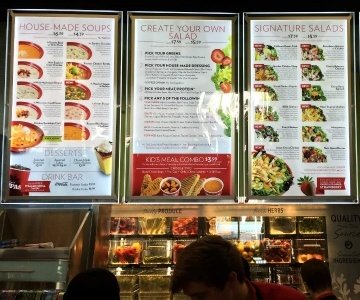
- “This establishment said they are too busy to take a phone order, yet they have a person opening the front door for guests? They responded to my inquiry, “she is not trained for phone orders”??!!! I am now going to be too busy to give my hard-earned money for undertrained staff!!” (Ron’s comment: Never be too busy to take an order or serve a customer. Due to frustration, this customer discontinued buying catered meals for his business meetings. On the other hand, an untrained person should not take complicated phone orders. Which business system is to blame, training, scheduling staff, or something else?)
- “They tell you, when you are through eating to just leave your dishes, they will clean it all up for you. Then they say, please no tipping. The restrooms are very clean. Thinking of how many people are in and out of there during the lunch rush, I was impressed!” (Ron’s comment: Notice three great elements to their customer-service system—staff cleans the tables, open refusal to take tips, and very clean restrooms, even during busy hours.)
- “The food is pretty good, but they need to work on the ordering process. You have to walk through a hurried line where every person asks you what you ordered or if you want what they have to offer. At the end of the line, there is a disorganized pile of prepared dishes and you are expected to remember the names of everything you ordered to figure out which combination of soup, salad, or sandwich is yours.” (Ron’s comment: I’ve had the same difficulty. This system would be easy to improve. What would you do to make it easy for the customer to recognize their order at the end of the line?)
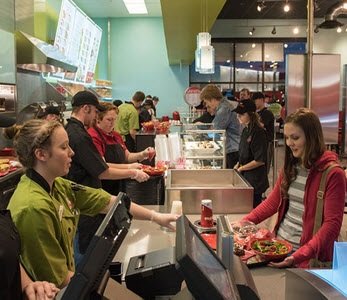
- “I was told the corporate office ‘didn’t have a phone number. Of course, anyone with any sense knows that a corporate office HAS a phone number. So that means that they just don’t want to speak with their ACTUAL CUSTOMERS! Ahh… that’s a wonderful business model.. NOT! And.. what do you know.. . with a little bit of extra research.. I found that indeed they do have a phone number. Surprise! I posted it for others, even though they prefer to hide and remain out of touch.” (Ron’s comment: A lot of companies today make it difficult for customers to contact them; they prefer email and online methods. However, when a large company does not have a posted phone number, I often shop elsewhere to ensure I can get a problem resolved if necessary. This is a company decision and a business system I think Zupas could improve upon. Some companies promote their phone number. They want to know what customers think.)
- “I thought this place was going to be obnoxious and/or complicated on first site, but once I actually got my butt inside, and looked at the menu, it was evident that it’s not that complicated, expensive, obnoxious atmosphere, or stingy on the servings. Pretty much whatever you order will be delicious and I’m a total sucker for those chocolate-covered strawberries. These guys just totally nailed it. It’s really different from pretty much any other place, like a combination of Pita Jungle and Panera, but way better than both combined.” (Ron’s comment: This review reflects what the owners are striving for—the kind of 5-star rating that makes us smile!)
Every customer YOU have could write reviews like those above. Your customers or clients have very specific feelings about the way you do business, about the way you treat them, and about your unique business “recipes.” Some customers don’t return, and you’ll never know why. Other customers come back often, and you should know why. To be successful, systemize every good thing you want to have happen—what you want your employees to do, what you want your customers to experience. There is no other way!
What Employees Are Saying
Now let’s get some insight based upon what employees of Café Zupas have to say. Keep in mind that the comments made below often reflect a single store. However, when you see repeated issues, there may be a good reason to evaluate one or more business practices—your systems or processes (italics added for emphasis).
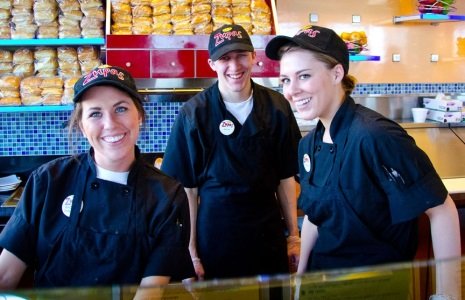
- “Tons of coworkers all around the same age (Ron: a result of the hiring system) makes for a fun work environment (the company culture). Half off food discount. Decent pay 8.50 starting (compensation system). Before opening, there is a meeting daily where you can discuss anything. It is great to keep things running smoothly (communication and business improvement system).
- “There are a lot of nit-picky rules and checklists that, while being helpful, can sometimes limit the efficiency of the employees.” (Ron’s comment: The company uses checklists to ensure quality and consistency, which comes before efficiency if you want customers to return.)
- “Zupas pushes customers through the line so quickly. It is ridiculous, unnecessarily fast, and not human. I remember getting so stressed and frustrated, I wanted to just walk away and never come back.” (Ron’s comment: The serving line moves fast. It is the nature of similar restaurants with high demand. This is probably why the company hands out menus at the door during busy times. Furthermore, arriving customers who see the line moving fast are less likely to go elsewhere.)
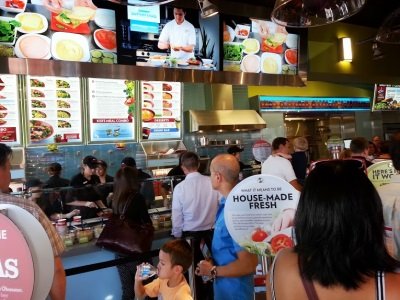
- “The training they give you (if done correctly) is awesome. It really goes in-depth and will teach you good customer service skills that can be used in future jobs. You’ll gain a sense of urgency and learn incredible customer service.” (Ron’s comment: From numerous employee reviews, Zupas’ training system is very thorough. The workers learn to execute with exactness.)
- “Please update the manuals and training books. Especially keep the Line Servers updated on changes in procedures.” (Ron’s Comment: I do believe this person is a Systems Thinker. Updating processes is important, followed by updated training. Yes, it is a lot of work, but if you want a customer-pleasing, waste-removing, profit-boosting business enterprise, it is necessary and will pay dividends. This is why franchising is so popular; successful systems and processes can be easily repeated in multiple locations.)
- “Give raises to your Line Servers especially if they have been working for you for more than three months! It is a constant struggle to keep employees, if you paid us more, fewer people would look for another job. You demand perfection and we work so hard for just being paid minimum wage. Why not invest more money in your current employees?” (Ron’s comment: Low wages and hard work are characteristic of many fast-food restaurants. That said, the turnover of people is also expensive. The media would have the public believe that a benevolent business owner could easily raise wages from say $8 to $15 per hour without consequence. However, the ability to do so actually depends on the customer’s expectation of pricing. Costs in most restaurants are roughly one-third for food, one-third for labor, and one-third for overhead (e.g. rent, insurance). The average fast-food restaurant makes about 3% net profit. While you could re-evaluate your pricing system and other business efficiencies—and a price increase might be possible—there may not be a lot of wiggle room. Too much increase could drive customers to your competitors, reduce sales volume, and send your break-even point to a later day of the month (not good). Truthfully, these young people are getting experience with value beyond current wages that will pay off in the future.)
- Employee comments about managers: “managers need to care more about the employees working for them; management is scattered and unorganized; the upper management dress so sloppy it is embarrassing; secretive meetings are held among managers, leaving lots of room for gossip among staff; they need more open communication and transparency; managers tell you there are opportunities to advance, but they will never give you a raise or any benefit.” (Ron’s comment: Managers’ style and skills will vary from store to store. I assume the Zupas’ training system includes managers. Poor management can be costly to a company—frustration, low morale, high turnover. Remember, employees are customers, too (see Five Customer Types). If this were my business, I may try a web-based system where employees can rate their managers and overall work experience with 1-5 stars regarding a variety of topics. I would then use the information in training to help managers improve. How would you, or do you, ensure first-rate managers in your business?)
- “I have never worked for such a wonderful company. Every member of corporate cares and they keep people focused on the right things in the restaurant, training, consistency in the food, and a fun, friendly, and clean restaurant. Keep up the great work!” (Ron’s comment: One of many 5-star ratings.)
Do YOUR employees enjoy coming to work or do they dread the thought? Do managers or workers experience frequent frustration? Are some, even now, looking for another job? As previously mentioned, it’s not easy to keep people happy, but you can develop enthusiasm, productivity, and loyalty by incorporating the right principles into your business systems and processes (see eCourse).
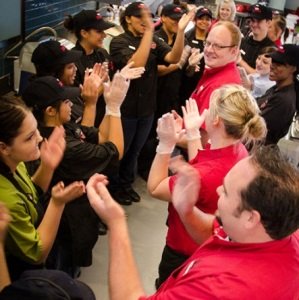
The Takeaway
So what do we learn from Café Zupas that can be applied to your business operation? Here are a few ideas:
- Every business has an ecosystem that supports the life and success of the enterprise. Is your ecosystem like Earth or like Mars?
- Your business as a whole is a recipe, a “franchise prototype” as Michael Gerber refers to it (E-Myth Revisited). Have you learned the Master Skill for creating a winning business model that works well even when you’re not around, or that can be replicated in other markets?
- Every business has “recipes”—systems and processes—for pleasing customers and delivering products and services. Those recipes can be unique, wonderful, and attention-getting or they can be lackluster, commonplace, and uninspiring. Do you have a world-class recipe for attracting new customers, hiring the best people, or providing “killer customer care”?
- What is your “sensory package” to draw people like a magnet? What would patrons say about the look and feel of your operation? Is it inviting, clean, and organized? Does it shine? What are you doing to WOW customers? What is your unique business advantage and value proposition? Do your customers know it? Is there a buzz in the marketplace about your company?
- Are the ingredients—the component parts—of your recipes the best you can make them? Many businesses have missing or poor-quality ingredients (e.g., forms, checklists, ad copy, signage, websites, software, equipment, people, and so forth).
- In today’s business environment, many companies are rated online. The brutal facts are in plain sight. Out of curiosity, how many items do YOU buy that are 3 stars? A 4-star rating is pretty much my bottom; 4 1/2 to 5 stars is preferred. I care about what other customers say, especially if there is a pattern. What could I read online about your business? Are you using the feedback to drill-down on faulty busy systems and processes and make the necessary course corrections?
- If business processes frustrate customers or employees, they will eventually go somewhere else. Improve your processes if you can. If you can’t change some of the things you are doing, listen, and carefully explain the reasons why (e.g., compensation limits, work schedules, product return policies). Invite suggestions, and treat people with respect. Knowing that you value their opinion is 90% of the battle.
- The business culture you create is significant. Business guru Peter Drucker said that “culture trumps strategy every time. Is your business culture helping you succeed?
- Some little things that matter a lot: Keep the restrooms clean. Make payroll on time. Recognize and reward value given. Keep promises. Resolve problems quickly. Offer good training. Listen to your customers, including employees. Manage by the numbers. Lead with humility, respect, and kindness (You could name others).
- System Thinking raises the details of your business operation from the sub-conscience to the conscious, making problems crystal clear and solutions apparent. Once you go there, you will never go back. Attention to detail and low-cost improvements can make your business remarkable.
Return to the Present
“Ron, are you listening to me. Have you heard a word I’ve said,” my beautiful, sweet, awesome companion blurts out while waving her hand to get my attention?
“Oh, sure, honey,” I instinctively reply as I do a soft landing back to reality. “I was just thinking about…. Oh, never mind.”
Afterthought: Just before posting this article (10/5/2015), I googled Café Zupas. To my surprise, a Zupas display ad appeared on the top-right with a 3.2-stars rating from 16 reviews. Three visible reviews said:
“I use to love Zupas but now I feel like I am paying for barely any food.”
“I ordered two (full) BBQ chicken salads today it was terrible!”
“I ended up getting two half salads with nothing but lettuce and sauce.”
Oopsie! Could this be the sign of a system breakdown (at least at one store)? Trust me. It can happen to anyone—even YOU (Learn how to fix a system breakdown, and 10 reasons why business systems fail).







